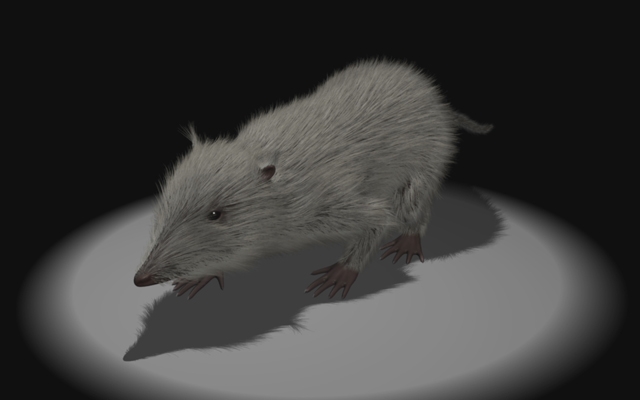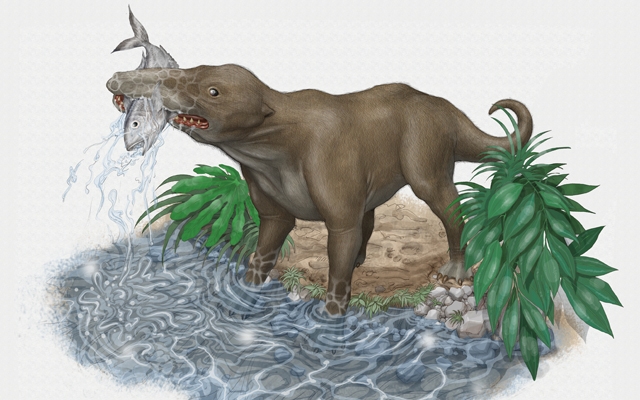
アデロバシレウス
Adelobasileus cromptoni

パキケトゥス
Pakicetus
新生代が始まると、中生代の末に絶滅した恐竜に代わって哺乳類が急激に多様化をはたした。現在まで続く哺乳類時代の始まりである。ここでは哺乳類のルーツを新生代の前にさかのぼって紹介しよう。
哺乳類の祖先は古生代末に出現した単弓類のキノドン類である。次の中生代の三畳紀には最古の哺乳類であるアデロバシレウスが出現した。しかし、この時期の哺乳類は恐竜の陰に隠れた存在でしかなく、多くは恐竜の衰退と共に中生代末までに絶滅してしまった。しかし、白亜紀に出現した2つのグループ、有胎盤類(別名:真獣類)と有袋類(後獣類)は中生代末の大量絶滅を生き残り、新生代において繁栄することに成功した。有胎盤類は体内の胎盤で子を一定期間育ててから出産するグループであり、現存する哺乳類のほとんどが所属する。一方の有袋類は腹の袋(育児嚢)で子を育てるグループであり、代表的な生物にはオーストラリアのカンガルーがいる。
新生代になると哺乳類は二段階にわたって多様化した。新生代の最初の古第三紀暁新世には、有胎盤類を中心に爆発的に多様化した。これを第一次適応放散と呼ぶ。しかし、この時期に出現したグループで現在まで残っているものは、霊長類や食虫類、食肉類などの一部に限られる。現在見ることができる哺乳類の多くは、次の古第三紀始新世に出現したグループである。これは第二次適応放散と呼ばれている。その中には奇蹄類(馬やサイの仲間)、鯨偶蹄類(クジラやカバの仲間)、翼手類(コウモリの仲間)、長鼻類(ゾウの仲間)などが含まれる。
この様に哺乳類は新生代の初期に爆発的に多様化したが、その中にはクジラやアザラシ、アシカ、ジュゴンなどの様に海に進出したものもいた。例えば、約5000万年前のパキスタンの水辺(※陸上)に生息したパキケトゥスと呼ばれる最古のクジラは、オオカミのような外見ながらも足には水かきを持っていた可能性が高いという。哺乳類の生活場は中生代までは陸上に限られていたが、新生代の初頭には海にも進出して大きく多様化したのである。
With the extinction of dinosaurs at the end of the Mesozoic, mammals were able to suddenly diversify at the beginning of the Cenozoic. It is the beginning of the reign of mammals. Let’s delve into mammals’ origin, far before the Cenozoic era.
Mammals are the descendants of the Cynodont, a synapsid that appeared during the late Paleozoic. However, the earliest mammal to appear is the Adelobasileus cromptoni during the Triassic. At this epoch, the dinosaurs shadowed mammals and a lot of them disappeared along with dinosaurs at the end of the Mesozoic. Fortunately, all mammals did not disappear at the end of the Cretaceous. Indeed, placentals (aka: Eutheria) and marsupials (aka: Metatheria) survived the extinction event and started to prospere during the Cenozoic. On one hand, animals belonging to the placentals give birth after raising the child for a certain period of time in the placenta situated in their body. Almost all existing mammals compose the placental group. On the other hand, the Marsupials raise their children in a pouch (marsupium). The best representative of the marsupial group is the Australian Kangaroo.
At the beginning of the Cenozoic, mammals diversified in two-steps. First, during the Paleocene (Early Paleogene), placentals underwent an explosive diversification. This explosion is referred to as the primary adaptive radiation. Among the group of mammals that appeared during the primary adaptive radiation, only remain nowadays a small number of primates, insectivores, carnivorous etc. In fact, many of the mammals we can see now, appeared later in the Eocene period during the second adaptive radiation. Among the groups born from the second adaptive radiation, we can cite the Perrissodactyla (Horses and Rhinoceros), the Cetartiodactyla (Whales and Hippopotamuses), the Proboscidea (elephant) and the Chiroptera (bats) etc.
With the early Cenozoic mammal's adaptive radiation explosion, many mammals also diversified and adapted to an aquatic lifestyle such as whales, seals, sea lions and dugongs. For example, the oldest whale called Pakicetus, which lived in Pakistan's waterside about 50 million years ago, was while it looked like a wolf, probably webbed feet. While limited to the land during the Mesozoic era, mammals diversified and conquered the seas and the sky in the early Cenozoic's days.